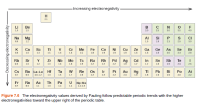
Chemistry
10th Edition
ISBN: 9781305957404
Author: Steven S. Zumdahl, Susan A. Zumdahl, Donald J. DeCoste
Publisher: Cengage Learning
expand_more
expand_more
format_list_bulleted
Concept explainers
Question
Silicones are

Transcribed Image Text:- Increasing electronegativity -
H
2.1
Li
Be
F
1.0
1.5
2.0
2.5
30
3.5
4.0
Na
Mg
AI
Si
CI
0.9
12
1.5
18
21
2.5
3.0
K
Sc
Ti
V
Cr
Mn
Fe
Co
Ni
Cu
Zn
Ga
Ge
As
Se
Br
0.8
1.0
1.3
15
1.6
1.6
1.5
18
1.9
1.9
19
1.6
1.6
18
20
24
2.8
Rb
Sr
Y
Zr
Nb
Mo
To
Ru
Rh
Pd
Ag
Cd
In
Sn
1.8
Sb
Те
0.8
1.0
1.2
1.4
1.6
1.8
1.9
22
2.2
2.2
19
1.7
1.7
19
2.1
2.5
Cs
Ba La-Lu
Hf
Ta
w
Re
Os
Ir
Pt
Au
Hg
TI
Pb
Bi
Po
At
0.7
0.9
10-1.2
1.3
1.5
1.7
1.9
22
2.2
2.2
24
1.9
1.8
19
19
2.0
22
Fr Ra Ac
0.9
Th Pa
U Np-No
0.7
11
1.3
1.4
1.4
14-13
Figure 7.6 The electronegativity values derived by Pauling follow predictable periodic trends with the higher
electronegativities toward the upper right of the periodic table.
Decreasing electronegativity
Expert Solution
This question has been solved!
Explore an expertly crafted, step-by-step solution for a thorough understanding of key concepts.
This is a popular solution
Trending nowThis is a popular solution!
Step by stepSolved in 6 steps with 2 images

Knowledge Booster
Learn more about
Need a deep-dive on the concept behind this application? Look no further. Learn more about this topic, chemistry and related others by exploring similar questions and additional content below.Similar questions
- Write resonance forms that describe the distribution of electrons in each of these molecules or ions. a) nitric acid, HNO3 (N is bonded to an OH group and two O atoms) b) benzene, C6H6: c)the formate ion:arrow_forwardDraw regular Lewis structures (no need to use dashed lines and wedges) for each of the following molecules and indicate which exception, if any, to the octet rule is found in each of them: SCI6, CH3, XeF4, BBR3.arrow_forwardUsing average bond enthalpies (linked above), estimate the enthalpy change for the following reaction: CH4(g) + Cl₂(g)-CH3CI(g) + HCl(g) kjarrow_forward
- Based on the bond energies for the reaction below, what is the enthalpy of the reaction? HC≡CH (g) + 5/2 O₂ (g) → 2 CO₂ (g) + H₂O (g)arrow_forwardWhen drawing the Lewis structure of the HCC13 molecule, the structure should represent a total of 26 valence electrons. What is the best description of the complete Lewis structure of the molecule? Select one: AH atom should be in the center with single bonds to each Cl atom and a double bond to the C atom. A Cl atom should be in the center with a single bond to the C atom and a single bond to the H atom. AC atom should be in the center with a double bond to the H atom and double bonds to each Cl atom. AC atom should be in the center with single bonds to each Cl atom and a single bond to the H atom.arrow_forwardTwo possible Lewis structures for the cyanate ion are shown below, with formal charges (FC) calculated for each atom. One structure has carbon as the central atom and the other has a nitrogen as a central atom. By considering formal charges, which arrangement of atoms is the best, and therefore most likely structure for cyanate? FC: -1 0 0 FC: -1 +1 -1 |:0—C=N:1 STRUCTURE A STRUCTURE B Structure A Structure B Both are equally likely QUESTION 19 Two possible Lewis structures for the thiocyanate ion are shown below, with formal charges (FC) calculated for each atom. One structure has carbon as the central atom and the other has a nitrogen as a central atom. By considering formal charges, which arrangement of atoms is the best, and therefore most likely structure for thiocyanate? FC: 00-1 FC: -1 +1 -1 Ec: STRUCTURE A STRUCTURE B O Structure A Structure Barrow_forward
arrow_back_ios
arrow_forward_ios
Recommended textbooks for you
 ChemistryChemistryISBN:9781305957404Author:Steven S. Zumdahl, Susan A. Zumdahl, Donald J. DeCostePublisher:Cengage Learning
ChemistryChemistryISBN:9781305957404Author:Steven S. Zumdahl, Susan A. Zumdahl, Donald J. DeCostePublisher:Cengage Learning ChemistryChemistryISBN:9781259911156Author:Raymond Chang Dr., Jason Overby ProfessorPublisher:McGraw-Hill Education
ChemistryChemistryISBN:9781259911156Author:Raymond Chang Dr., Jason Overby ProfessorPublisher:McGraw-Hill Education Principles of Instrumental AnalysisChemistryISBN:9781305577213Author:Douglas A. Skoog, F. James Holler, Stanley R. CrouchPublisher:Cengage Learning
Principles of Instrumental AnalysisChemistryISBN:9781305577213Author:Douglas A. Skoog, F. James Holler, Stanley R. CrouchPublisher:Cengage Learning Organic ChemistryChemistryISBN:9780078021558Author:Janice Gorzynski Smith Dr.Publisher:McGraw-Hill Education
Organic ChemistryChemistryISBN:9780078021558Author:Janice Gorzynski Smith Dr.Publisher:McGraw-Hill Education Chemistry: Principles and ReactionsChemistryISBN:9781305079373Author:William L. Masterton, Cecile N. HurleyPublisher:Cengage Learning
Chemistry: Principles and ReactionsChemistryISBN:9781305079373Author:William L. Masterton, Cecile N. HurleyPublisher:Cengage Learning Elementary Principles of Chemical Processes, Bind...ChemistryISBN:9781118431221Author:Richard M. Felder, Ronald W. Rousseau, Lisa G. BullardPublisher:WILEY
Elementary Principles of Chemical Processes, Bind...ChemistryISBN:9781118431221Author:Richard M. Felder, Ronald W. Rousseau, Lisa G. BullardPublisher:WILEY

Chemistry
Chemistry
ISBN:9781305957404
Author:Steven S. Zumdahl, Susan A. Zumdahl, Donald J. DeCoste
Publisher:Cengage Learning

Chemistry
Chemistry
ISBN:9781259911156
Author:Raymond Chang Dr., Jason Overby Professor
Publisher:McGraw-Hill Education

Principles of Instrumental Analysis
Chemistry
ISBN:9781305577213
Author:Douglas A. Skoog, F. James Holler, Stanley R. Crouch
Publisher:Cengage Learning

Organic Chemistry
Chemistry
ISBN:9780078021558
Author:Janice Gorzynski Smith Dr.
Publisher:McGraw-Hill Education

Chemistry: Principles and Reactions
Chemistry
ISBN:9781305079373
Author:William L. Masterton, Cecile N. Hurley
Publisher:Cengage Learning

Elementary Principles of Chemical Processes, Bind...
Chemistry
ISBN:9781118431221
Author:Richard M. Felder, Ronald W. Rousseau, Lisa G. Bullard
Publisher:WILEY